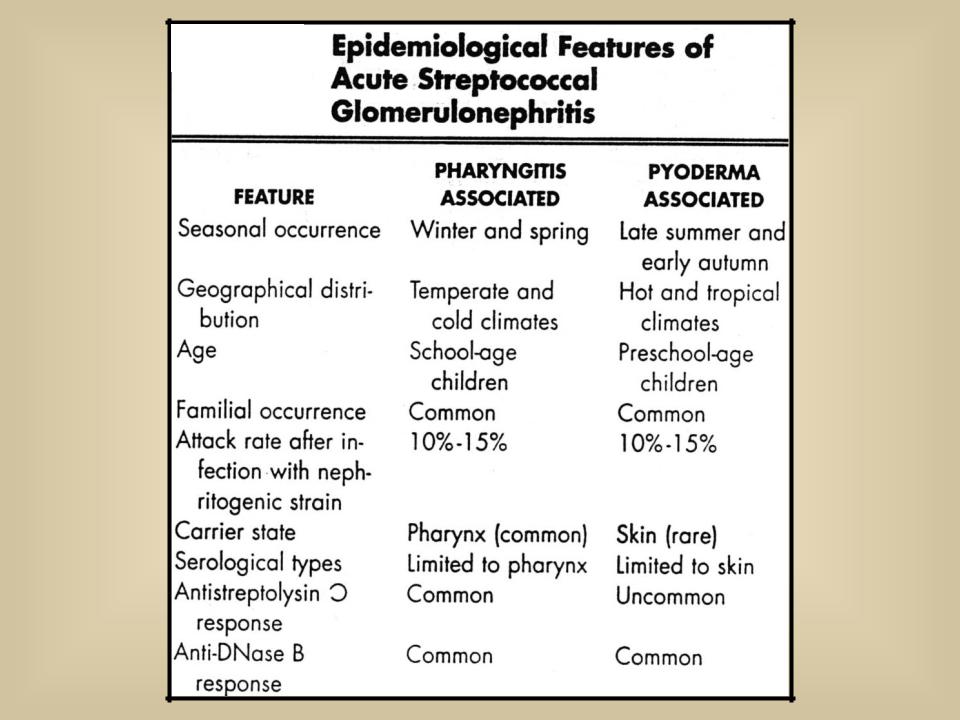
- •STREPTOCOCCUS
- •REVIEW
- •Common Cell Membrane
- •Gram-Positive Cell Wall
- •Peptidoglycan
- •Gram-Positive Cell Wall
- •Gram-Negative Cell Wall
- •Gram-Negative Cell Wall
- •Genus Streptococcus
- •Gram-Positive
- •Genus Streptococcus
- •Genus Streptococcus
- •Antigenic Structure
- •Antigenic Structure
- •Antigenic Structure (cont.)
- •Lancefield Serogroup Classification of
- •Streptococcus
- •Lancefield Serogroup Classification of
- •Streptococcus
- •Lancefield Classification of Beta- Hemolytic Streptococci (cont.)
- •Major Human Diseases of
- •Erysipelas
- •Major Human Diseases of
- •Suppurative Streptococcal Diseases
- •Group A Streptococcal Diseases (cont.)
- •Epidemiology of Acute Streptococcal Infection
- •Nonsuppurative Sequelae of Acute Group A Streptococcal Infection
- •Nonsuppurative Sequelae of Acute Group A Streptococcal Infection (cont.)
- •Determinants of Pathogenicity
- •Extracellular Virulence Factors
- •Extracellellular Virulence Factors (cont.)
- •Extracellular Virulence Factors (cont.)
- •Extracellular Virulence Factors (cont.)
- •Lab Identification of
- •Lab Identification of
- •Group B Streptococcus
- •Group B Streptococcal Infections
- •Grp B Streptococcal Infections (cont.)
- •Age-Specific Attack Rates of Group B
- •Epidemiology of Neonatal Group B
- •Group B Streptococcus
- •CAMP Factor Test
- •Hippurase NEG
- •Grp B Streptococci
- •Streptococcus pneumoniae
- •Streptococcus pneumoniae Infections
- •Pneumococcal Infections (cont.)
- •S.pneumoniae
- •S. pneumoniae: lancet-shaped diplococcus
- •S. pneumoniae Virulence Factors
- •S. pneumoniae Seasonal Incidence
- •Comparison
- •Genetic Variation (Mutation)
- •Beginning of Molecular Genetics
- •Transformation (In vivo) (Griffith)
- •Streptococcus pneumoniae
- •Optochin Sensitivity
- •Enterococcus faecalis Enterococcus faecium
- •Enterococcal Infections
- •Enterococcal Infections (cont.)
- •Important nosocomial pathogen
- •Enterococcus
- •Enterococcus
- •Esculin
- •REVIEW
- •Lancefield Serogroup Classification of
- •Nonsuppurative Sequelae of Acute Group A Streptococcal Infection
- •Nonsuppurative Sequelae of Acute Group A Streptococcal Infection (cont.)
- •Determinants of Pathogenicity
- •Extracellular Virulence Factors
- •Extracellellular Virulence Factors (cont.)
- •Extracellular Virulence Factors (cont.)
- •Extracellular Virulence Factors (cont.)
- •Epidemiology of Neonatal Group B
- •REVIEW
- •Streptococcus pneumoniae Infections
- •S.pneumoniae Virulence Factors
- •Comparison
- •Genetic Variation (Mutation)
- •Beginning of Molecular Genetics
- •Transformation (In vivo) (Griffith)
- •Enterococcal Infections

Group A Streptococcal Diseases (cont.)
Nonsuppurative Sequelae
Post-infection complications of Group A streptococcal disease; Serious complications in pre-antibiotic era; still important in developing countries
Acute rheumatic fever (ARF):
Inflammation of heart, joints, blood vessels, sub- cutaneous tissues
Rheumatic heart disease (RHD):
Chronic, progressive heart valve damage
Acute glomerulonephritis (AG):
Acute inflammation of renal (kidney) glomeruli
Foodborne Disease

Epidemiology of Acute Streptococcal Infection
• Predilection for upper respiratory tract or skin
•Group A commonly colonize oropharynx of healthy children
•M-types of strains colonizing throat differ from those on skin
•Rapidly killed after phagocytosis, but cell walls not digested and may lead to chronic inflammatory lesions
Pharyngitis transmitted by droplets from respiratory secretions
• Crowding increases risk (e.g., classrooms, day care facilities)
Pyoderma transmitted by direct contact with infectious lesions

Nonsuppurative Sequelae of Acute Group A Streptococcal Infection
Acute Rheumatic Fever (ARF)
Inflammatory reaction characterized by arthritis, carditis, chorea (disorder of CNS with involuntary spastic movements), erythema marginatum (skin redness with defined margin), or subcutaneous nodules
Within 2-3 weeks following pharyngitis
•Epidemic pharyngitis: ARF in as many as 3%
•Sporadic pharyngitis: ARF in 1 per 1000
Morbidity & mortality linked to subsequent disease of heart valve
(Rheumatic Heart Disease)
Poorly understood pathogenesis with several proposed theories including cross-reactivity of heart tissues & strep AGNs
•?? (Type II hypersensitivity, exotoxins, direct invasion)

Nonsuppurative Sequelae of Acute Group A Streptococcal Infection (cont.)
Acute Glomerulonephritis
Follows either respiratory (pharyngitis) or cutaneous (pyoderma) streptococcal infection
Associated with well-defined group of M-types Incidence varies from <1% to 10-15%
Most often seen in children manifesting as dark, smoky urine with RBC's, RBC casts, white blood cells, depressed serum complement, decreased glomerular filtration rate
Latent period: 1-2 weeks after skin infection and 2-3 weeks after pharyngitis
Granular accumulations of immunoglobulin due to deposition of immune complexes within the kidney
(Type III Hypersensitivity)


Determinants of Pathogenicity
Cellular Virulence Factors
Capsule
Antiphagocytic; Nonspecific adherence
Hyaluronic acid (polysaccharide) mimics animal tissue
Lipoteichoic Acid
Cytotoxic for wide variety of cells
Adherence: Complexes with M protein (LTA-M) and binds to fibronectin on epithelial cells
M-Protein
LTA-M protein is adhesin
Antiphagocytic
Inhibits alternate C’ pathway and opsonization
M-like Proteins: bind IgM and IgG
F Protein: mediates adherence

Extracellular Virulence Factors
Exotoxins:
Streptolysin O (SLO):
Hemolytic and Cytolytic
Prototype of oxygen-labile and thiol-activated cytolytic exotoxins (e.g., Streptococcus, Bacillus, Clostridium, Listeria)
Lytic for variety of cells: bind to cholesterol- containing membranes and form arc- or ring- shaped oligomers that make cell leaky (RBC's, WBC’s, PMN's, platelets, etc.)
Causes sub-surface hemolysis on BAP Stimulate release of lysosomal enzymes
SLO titer indicates recent infection (300-500 in pediatric populations)

Extracellellular Virulence Factors (cont.)
Exotoxins (cont.):
Streptolysin S (SLS):
Hemolytic and Cytolytic Oxygen stable, non-antigenic
Lytic for red and white blood cells and wall-less forms (protoplast, L- forms)
Causes surface hemolysis on BAP
Lysogeny: Lysogenized bacteriophages play key role in directing synthesis of various Group A streptococcal enzymes and toxins
•Pyrogenic Exotoxin (erythrogenic toxin)
•Phage-associated muralysins (lyse cell walls) produced by both Groups A and C

Extracellular Virulence Factors (cont.)
Exotoxins (cont):
Pyrogenic (Erythrogenic) Exotoxins (Types A, B &C)
Produced by more than 90% of Grp A strep Lysogeny: Structural gene is carried by temperate bacteriophage, as is the case with diphtheria toxin
Mediate pyrogenicity (fever)
Causes scarlet fever (scarletiniform) rash
Increase susceptibility to endotoxic shock
Type C toxin increases permeability of blood-brain barrier
Enhance DTH
Mitogenic for T lymphocytes (cause cell division), myocardial and hepatic necrosis, decrease in antibody synthesis
Immunomodulators (superantigens): stimulate T cells to release cytokines
Cardiohepatic toxin

Extracellular Virulence Factors (cont.)
Enzymes:
Nucleases: Four antigenic types (A,B,C,D)
Facilitate liquefication of pus generating growth substrates Nucleases A, C have DNase activity
Nucleases B, D also have RNase activity
Streptokinases: Two different forms
Lyse blood clots: catalyze conversion of plasminogen to plasmin, leading to digestion of fibrin
C5a Peptidase: destroys C’ chemotactic signals (C5a) Hyaluronidase: hydrolyzes hyaluronic acid
Others: Proteinase, NADase, ATPase, phosphatase, etc.
